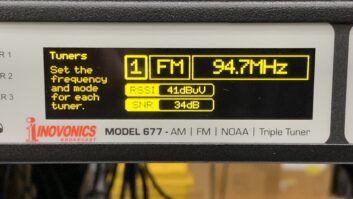The RWEE mailbox received two thoughtful letters this month (to [email protected]) from longtime friends of the publication.

The Pin 7 output of the Raspberry Pi Zero “Transmitter” at 87.5 MHz. Hal Kneller of Punta Gourda, Fla., had positive remarks about Meenakshi Singhvi’s article “A Primer on FM Combiners” (RWEE, April 20). Hal commented, “Typically at 400 kHz spacing, two antenna arrays are used, staggering the channels, thus the spacing in the combiner for any one frequency to another would be 800 kHz which is very doable. I offered the comment because Ms. Singhvi indicated that at 400 kHz, combining becomes more difficult.
“That’s why in other parts of the world where they have 400 kHz spacing in the same city (Europe for instance, and places in the Middle East), the two-antenna approach is used to lessen the problem.”
Harold Hallikainen of Ultra Stereo Labs, San Luis Obispo, Calif., was intrigued by the transformation of a Raspberry Pi Zero computer into an FM RBDS “transmitter” in “Rich Rarey and His Stupid Pi Tricks” in the same issue.
“Interesting!” Harold wrote. “What does the waveform on the GPIO pin look like? I suspect it’s a square wave at a subharmonic of the FM frequency. If it’s done with a Pulse Width Modulation (PWM) output, the frequency can be changed by writing to the period register.
“It’s hard to get much resolution if the period is small. I’ve always thought Direct Digital Synthesis (DDS) was an interesting technique. I used an Analog Devices chip to do DDS for a local oscillator in front of a Belar FMM-2.”
I replied to Harold that this stupid Pi trick uses GPIO 4 (physical Pin 7). The Raspberry Pi’s PWM output is on Pin 12 (GPIO 18). The April RWEE issue didn’t have room for the spectrum analyzer screen shot that was centered on the “transmitter” output frequency in the April issue, so I’m including it here for your amusement.












